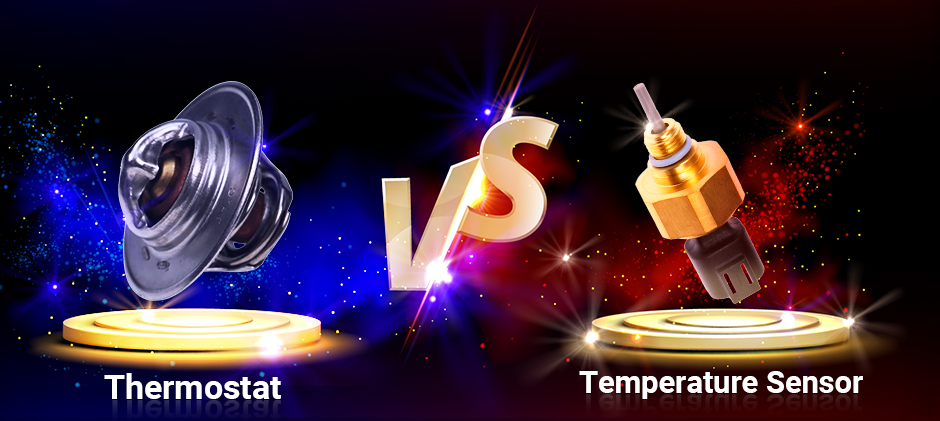Temperature sensors and thermostats are two frequently used tools in winter for many heavy equipment owners or operators. As they do have something in common in functions, many novice operators may mix them up. However, these components each play essential roles in monitoring and regulating engine temperatures, ensuring that machinery operates smoothly, even in extreme conditions. In this guide, I will help you understand the roles of temperature sensors and thermostats, their major differences, and how to choose the right one for your heavy equipment.
What Is a Temperature Sensor and How Does It Work in Heavy Machinery?
A temperature sensor is a device that measures and monitors the temperature within various parts of heavy machinery, particularly the engine. The most common type for heavy machinery is the engine temperature sensor, which detects engine heat and sends real-time data to the machine’s control unit. This data helps operators know if the engine’s temperature exceeds safe limits, preventing overheating issues. By accurately measuring temperature, these sensors ensure efficient machine performance and prolong the equipment’s lifespan.
Temperature sensors are vital for keeping an eye on the engine temperature sensor readings in challenging environments, where even minor fluctuations can signal potential issues. This constant monitoring allows operators to identify and address problems early, avoiding costly repairs and downtime.
What Is a Thermostat and Why Is It Crucial for Heavy Equipment?
A thermostat is a temperature-regulating device that controls the flow of coolant to maintain the optimal engine temperature. It opens and closes based on the engine’s temperature, allowing coolant to circulate when necessary and preventing it when the engine is already cool. This mechanism ensures the engine doesn’t overheat or run too cold. Thus, maintaining efficient performance and protecting critical components.
So why is the thermostat essential for heavy machinery? It was mainly because it regulates temperature fluctuations automatically, providing a stable environment for optimal operation. I can tell you that without a properly functioning thermostat, engines may either overheat, causing wear and tear, or run inefficiently, leading to poor fuel economy and increased emissions.

Temperature Sensors vs Thermostats: Major differences
I believe that if you go through the above 2 paragraphs, you have gained a basic understanding of what is a temperature sensor and a thermostat. Although they both play important roles in managing temperature, they serve distinct functions. Here is a breakdown of their key differences for you:
Function: A temperature sensor measures temperature, while a thermostat controls temperature by managing coolant flow.
Mechanism: Temperature sensors detect and report temperature, helping the control unit monitor the system, while thermostats physically regulate coolant based on the detected temperature.
Purpose: Temperature sensors focus on providing data, while thermostats actively control the temperature to maintain optimal engine conditions.
So while a temperature sensor alerts you to temperature changes, the thermostat takes action. Together, they allow your machinery to operate safely.
How to Choose Between a Temperature Sensor and a Thermostat for Your Machine
As we know the different definitions, applications, and functions of a temperature sensor and a thermostat, choosing between them depends on your equipment’s specific needs. Here I provide some examples just for your reference:
Monitoring Needs: If your machinery requires constant temperature monitoring, a temperature sensor, particularly an engine temperature sensor, would be essential.
Temperature Regulation: When active control of temperature is necessary to protect the engine from overheating, a thermostat should be a priority.
Operating Environment: In harsh conditions where temperature spikes are common, both a thermostat and a sensor might be necessary for complete temperature management.
I have to say investing in a high-quality temperature sensor or thermostat may cost more upfront, but it is still worthwhile especially in winter seasons, as the equipment coolant system faces extra pressures under an extreme temperature condition. If you are worried about the price, you can turn to FridayParts.com for help. We are a professional online store specializing in providing effective engine and electrical system solutions at a fair price. As our slogan says, fix it once, fix it right, the shopping experience will save you from frequent replacements and potential engine issues down the line.
Thermostat replacement is not as hard as you may think, here are DIY tips for you.
Buying Guide: How to Choose the Best Temperature Sensors and Thermostats?
There are 3 main considerations when picking a temperature sensor or a thermostat: compatibility, accuracy, and reliability.
Compatibility: Ensure the temperature sensor or thermostat fits your machinery’s model and engine type.
Temperature Range: Choose a device that can withstand the operational temperatures your machine typically encounters.
Reliability: look for brands or platforms with reputations in heavy machinery parts for offering high-quality and durable components. FridayParts offers a 90-day return policy and a 1-year warranty, and with its reputation over the years in the industry, it is a reliable shop to purchase a temperature sensor or a thermostat.
Conclusion
I am sure that after reading the article, you already know what temperature sensors and thermostats do respectively. While a temperature sensor measures and monitors heat, a thermostat regulates it, each playing a critical role in your machine’s performance. By choosing the right components and recognizing your equipment’ special needs, you can prevent overheating and further damage to your coolant system and engine. In the end, I would like to wish you a happy winter season with your tractor, mower, or any other machinery a smooth ride.
